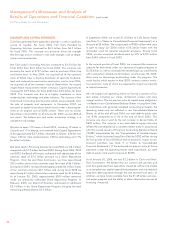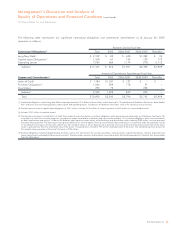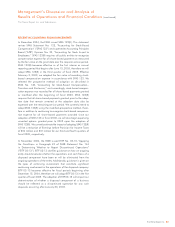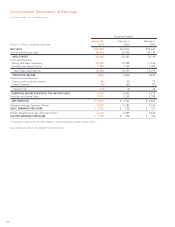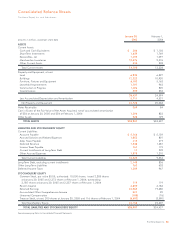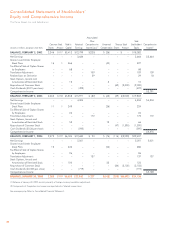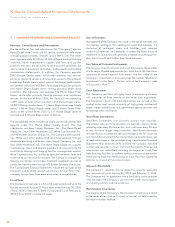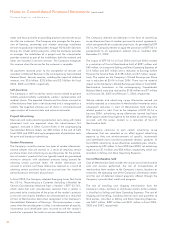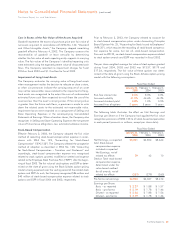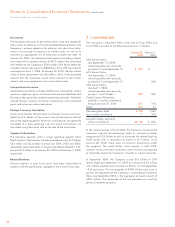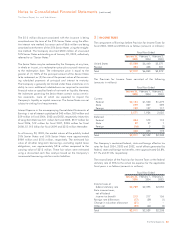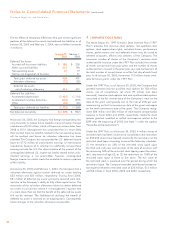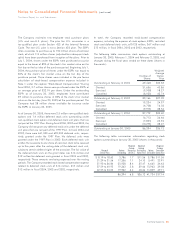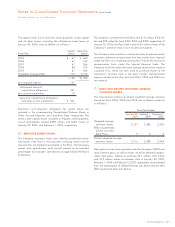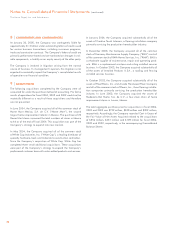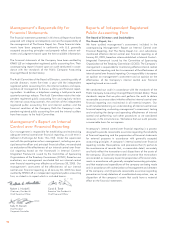Home Depot 2004 Annual Report Download - page 32
Download and view the complete annual report
Please find page 32 of the 2004 Home Depot annual report below. You can navigate through the pages in the report by either clicking on the pages listed below, or by using the keyword search tool below to find specific information within the annual report.
Notes to Consolidated Financial Statements (continued)
The Home Depot, Inc. and Subsidiaries
30
stores and focus primarily on providing products and services to our
do-it-for-me customers. The Company also arranges for the provi-
sion of flooring, countertop and window coverings installation
services to production homebuilders through HD Builder Solutions
Group, Inc. Under certain programs, when the Company provides
or arranges the installation of a project and the subcontractor
provides material as part of the installation, both the material and
labor are included in services revenue. The Company recognizes
this revenue when the service for the customer is complete.
All payments received prior to the completion of services are
recorded in Deferred Revenue in the accompanying Consolidated
Balance Sheets. Services revenue, including the impact of deferred
revenue, was $3.6 billion, $2.8 billion and $2.0 billion for fiscal
2004, 2003 and 2002, respectively.
Self-Insurance
The Company is self-insured for certain losses related to general
liability, product liability, automobile, workers’ compensation and
medical claims. The expected ultimate cost for claims incurred as
of the balance sheet date is not discounted and is recognized as a
liability. The expected ultimate cost of claims is estimated based
upon analysis of historical data and actuarial estimates.
Prepaid Advertising
Television and radio advertising production costs along with media
placement costs are expensed when the advertisement first
appears. Included in Other Current Assets in the accompanying
Consolidated Balance Sheets are $33 million at the end of both
fiscal 2004 and 2003 relating to prepayments of production costs
for print and broadcast advertising.
Vendor Allowances
The Company currently receives two types of vendor allowances:
volume rebates that are earned as a result of attaining certain
purchase levels and advertising co-op allowances for the promo-
tion of vendors’ products that are typically based on guaranteed
minimum amounts with additional amounts being earned for
attaining certain purchase levels. All vendor allowances are
accrued as earned, and those allowances received as a result of
attaining certain purchase levels are accrued over the incentive
period based on estimates of purchases.
In fiscal 2003, the Company adopted Emerging Issues Task Force
No. 02-16, “Accounting by a Customer (Including a Reseller) for
Certain Consideration Received from a Vendor” (“EITF 02-16”),
which states that cash consideration received from a vendor is
presumed to be a reduction of the prices of the vendor’s products
or services and should, therefore, be characterized as a reduction
of Cost of Merchandise Sold when recognized in the Company’s
Consolidated Statements of Earnings. That presumption is over-
come when the consideration is either a reimbursement of specific,
incremental and identifiable costs incurred to sell the vendor’s
product or a payment for assets or services delivered to the vendor.
The Company received consideration in the form of advertising
co-op allowances from its vendors pursuant to annual agreements,
which are generally on a calendar year basis. As permitted by EITF
02-16, the Company elected to apply the provisions of EITF 02-16
prospectively to all agreements entered into or modified after
December 31, 2002.
The impact of EITF 02-16 in fiscal 2004 and fiscal 2003 resulted
in a reduction of Cost of Merchandise Sold of $891 million and
$40 million, an increase to Selling and Store Operating Expenses of
$1.0 billion and $47 million and a reduction to Earnings before
Provision for Income Taxes of $158 million and $7 million, respec-
tively. The impact on the Company’s Diluted Earnings per Share
was a reduction of $0.04 in fiscal 2004. There was no material
impact on the Company’s Diluted Earnings per Share in fiscal 2003.
Merchandise Inventories in the accompanying Consolidated
Balance Sheets were also reduced by $158 million and $7 million
as of January 30, 2005 and February 1, 2004, respectively.
Volume rebates and advertising co-op allowances earned are
initially recorded as a reduction in Merchandise Inventories and a
subsequent reduction in Cost of Merchandise Sold when the
related product is sold. Prior to the adoption of EITF 02-16 in
January 2004, advertising co-op allowances earned had been
offset against advertising expense to the extent of advertising costs
incurred, with the excess treated as a reduction of Cost of
Merchandise Sold.
The Company continues to earn certain advertising co-op
allowances that are recorded as an offset against advertising
expense as they are reimbursements of specific, incremental
and identifiable costs incurred to promote vendors’ products. In
fiscal 2002, advertising co-op allowances exceeded gross advertis-
ing expense by $30 million. In fiscal 2004 and 2003, net advertising
expense was $1.0 billion and $58 million, respectively, which was
recorded in Selling and Store Operating Expenses.
Cost of Merchandise Sold
Cost of Merchandise Sold includes the actual cost of merchandise
sold and services performed, the cost of transportation of
merchandise from vendors to the Company’s stores, locations or
customers, the operating cost of the Company’s distribution centers
and the cost of deferred interest programs offered through the
Company’s private label credit card program.
The cost of handling and shipping merchandise from the
Company’s stores, locations or distribution centers to the customer
is classified as Selling and Store Operating Expenses. The cost of
shipping and handling, including internal costs and payments to
third parties, classified as Selling and Store Operating Expenses,
was $427 million, $387 million and $341 million in fiscal 2004,
2003 and 2002, respectively.


